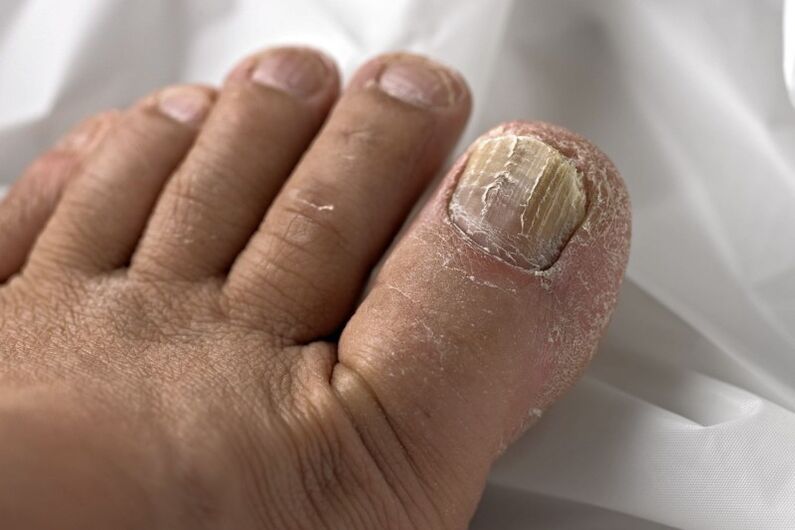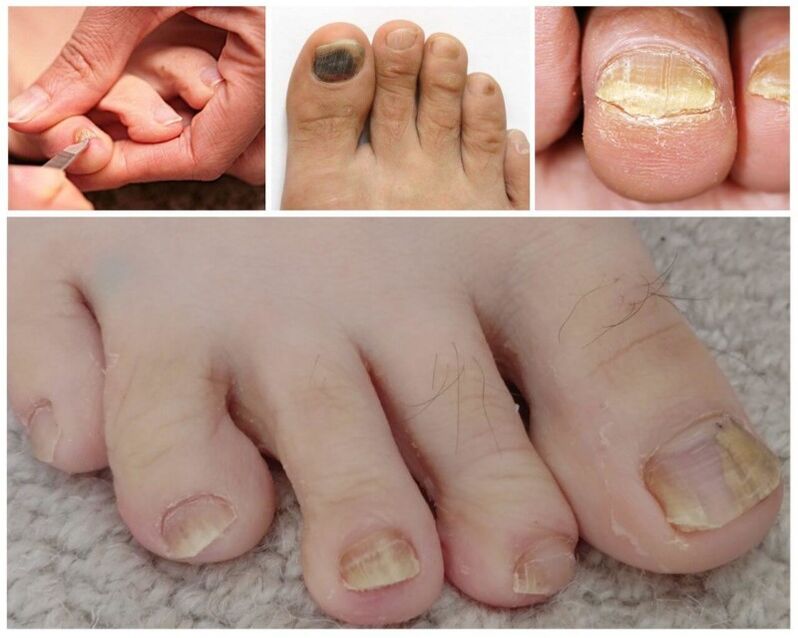Many people face diseases that affect the nails. But not everyone knows which doctor treats foot and hand nail fungus. Refusal of treatment leads to the development of dystrophy. It can become dangerous as the infection keeps progressing and "taking over new territories". It is important to see a specialist immediately when the first symptoms of a lesion appear. The choice of doctor largely depends on the general condition of the patient.

symptoms of a mycosis
In the early stages, the fungal infection does not manifest itself in any way. The appearance of the first symptoms goes unnoticed. A healthy nail is pink and shiny. When infected, it fades, becomes dirty gray.
Gradually, the nail plate thickens, it becomes difficult to cut the free edge with scissors. In later stages, hyperkeratosis develops, the nails become yellow and brittle. Over time, the plate moves away from the nail bed. As a result, the resulting cavities are filled with pathogenic microorganisms that are part of the skin microflora. Immunity goes down. There are complications in the form of attachment of a bacterial component. In the advanced stage, the fungus spreads to the periungual ridges and the foot becomes infected. The skin is very itchy and cracks, the toes are covered with painful cracks.

What needs to be done to cure mycosis?
You can return your nails to their former healthy appearance by using complex antifungal therapy. Patients are prescribed oral antifungal drugs in tablet form. They act on pathogenic microorganisms located in the deepest layers of the horny layer. The active ingredients of topical preparations cannot reach them, therefore, treatment of affected nail plates with creams and ointments, solutions and varnishes with antifungal properties without systemic preparations does not allow to achieve the desired therapeutic effect.
There are several groups of antifungal drugs. Some of them act against dermatophytes, others against mold and yeast-like fungi. The appointment is made after identification of the pathogen of the nail fungus. For this purpose, a scraping is made from the affected area. Biological material is sent for microscopy and bacteriological culture. They additionally allow determining the sensitivity of pathogenic microorganisms to a specific group of antifungal agents.
Which doctor should I contact if there is fungus of the toenails
In order to conduct an examination and make a correct diagnosis, you need to contact a dermatologist, a mycologist or a podiatrist.
- A dermatologist is a generalist who treats all kinds of skin diseases caused by various provocative factors. You need to go to him for first aid. If necessary, he can refer the patient to a mycologist.
- A mycologist is a narrow profile specialist. He is engaged in the treatment and prevention of infections, the development of which occurs after infection with fungi. He knows everything about these disease-causing microorganisms, so he can easily identify the type of infection and choose the right drugs to suppress it.
- A podiatrist is a master podiatrist with medical training. It treats cosmetic defects, the development of which can provoke foot deformities. Its task is to detect and identify pathological changes in the early stages of development and to develop therapy that can be carried out in a beauty salon (removing an ingrown nail, cleaning the horny layer, removing corns and cracks). If problems are identified that he cannot cope with, the doctor writes out a referral to a narrow specialist (to a dermatologist, a surgeon or a mycologist).

Initial examination by a doctor
Whoever the patient turns to, the initial examination is the same everywhere:
- First, the doctor interviews the patient, collects all the complaints, describes the history of the pathology in history.
- Then a visual inspection of the affected nails is performed, the condition of the skin surrounding the infected nails is assessed.
- According to the patient's complaints, according to the characteristics of the course of the disease, according to the symptoms, the specialist tries to make a preliminary diagnosis and distinguish a fungal infection from psoriasis, lichen.
- Then he necessarily writes an instruction for laboratory tests. They allow you to confirm the diagnosis, identify the pathogen and indicate the degree of its sensitivity to existing drugs.
Treatment tactics are developed only according to the results of a laboratory study. In each case, the therapeutic scheme may be different: it all depends on what stage the disease is at.
Treatment of nail fungus in its early stages
The initial stage of infection develops without any visible symptoms.

But it is also easy to diagnose if you pay attention to minor changes in the structure of the nail plate.
- First, the free edge of the nail turns slightly yellow.
- The thickness of the horny layer increases, which is noticeable in comparison to the thickness of healthy nails.
- When feet sweat, a characteristic sour odor appears.
If one or three of the listed signs are detected, you need to make an appointment with a mycologist. If there is no such doctor in the clinic, then a consultation with a dermatologist makes sense. At this stage, the infection can be treated with folk remedies and antifungal drugs intended for topical treatment. The therapeutic scheme in this case is as follows:
- Every day, the legs are pre-soldered in baths with the addition of decoctions of chamomile or potassium permanganate. They disinfect the skin and prevent the adhesion of the bacterial component. It's better to do them at night.
- After thoroughly drying the nails with a towel, a cotton pad is applied to the affected plates, abundantly moistened with a solution of apple cider vinegar, vodka and glycerin (the first two ingredients are mixed in half, a spoonful of the third component is added to them). After half an hour, the compress is removed. The fungus does not tolerate an acidic environment and stops multiplying.
- A few drops of iodine (5%) are applied daily to the affected plate in the morning.
- Every other day in the first month you need to cover your nails with antifungal varnish. In the second month, the varnish is used twice a week, in the following months once every seven days.
Experts recommend continuing the treatment until the healthy nail plate fully grows back (about three to four months). Periodically, it makes sense to visit your doctor and monitor the effectiveness of the therapy used by him. If necessary, a dermatologist or mycologist can make changes to the treatment regimen, adding antifungal ointments or disinfectant solutions.
Therapy of advanced mycosis
If a comprehensive treatment regimen does not help to overcome mycosis, the specialist may decide to remove the affected nail. This can be done in several ways.
Surgical intervention makes it possible to solve the indicated problem in the shortest possible time. The patient receives a referral to the surgeon for the procedure. The doctor removes the nail with a scalpel, then sutures and an antiseptic bandage are applied to the wound. The recovery period lasts two weeks. The patient undergoes antibacterial therapy, walks daily to bandage the operated finger. Home after discharge.
If there are contraindications to surgical intervention, the nail is removed with special plasters. They are glued to the plates and left there for five to six days, after which the condition of the nail is assessed. If necessary, the procedure will be resumed. The composition of the patches includes substances that soften and dissolve the stratum corneum. The remains of the nail are then removed with scissors.
To remove the plate, the patient may be offered laser therapy. The horny layer is burned with the help of a special light pulse. This procedure is painless, performed under local anesthesia and there is no postoperative period. To achieve a therapeutic result, eight procedures must be performed. A lot of people are not happy with that.
Preventive measures for the patient and his relatives
The fungus reproduces by spores, they spread long distances with air currents, fertilizing any surface. Infection is transmitted indirectly through contact with contaminated objects. Therefore, if there is a sick person in the house, their family members should take special precautions. It is forbidden:
- putting on the shoes of a sick person barefoot;
- Use his bathing supplies and tools he uses to perform a pedicure.
- go around the house barefoot;
- neglect the rules of personal hygiene;
When entering the bath, bath or sauna, it makes sense to put on extra shoes on your feet. It is important to properly care for the feet, constantly strengthen the immune system and enrich the diet with foods rich in vitamins and minerals. See a doctor at the first sign of infection.
























